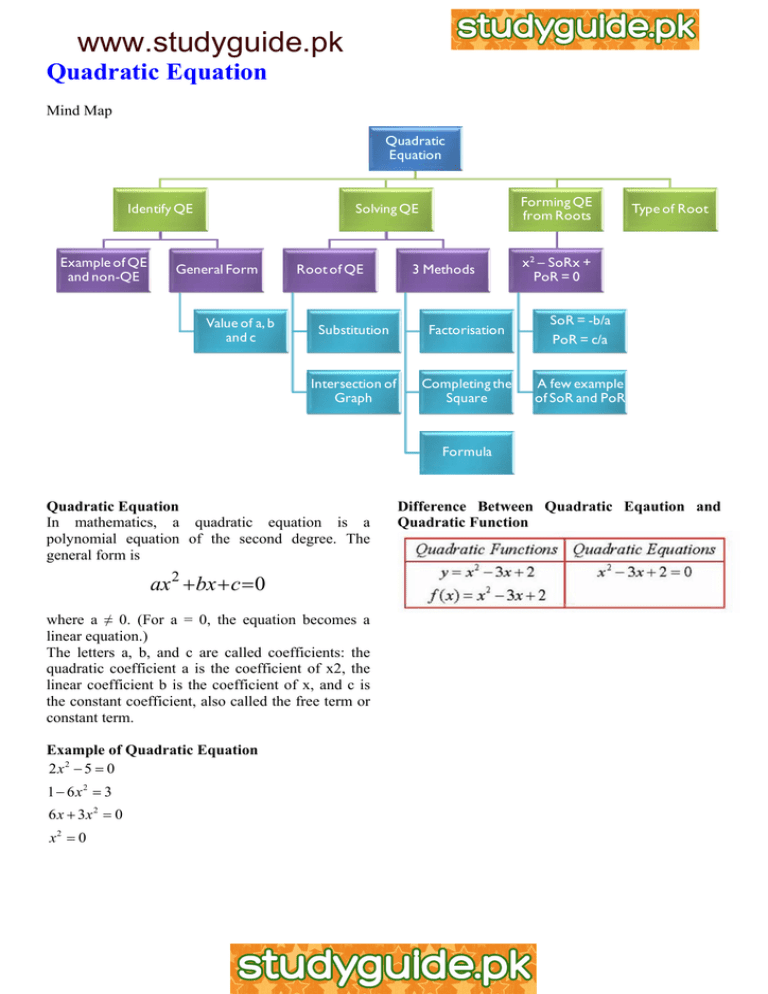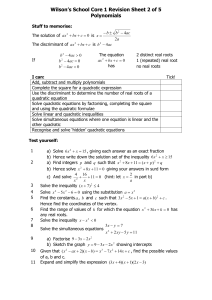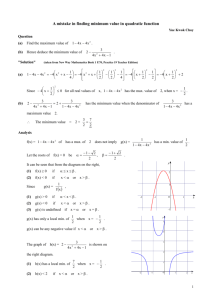www.studyguide.pk Quadratic Equation Mind Map
advertisement

www.studyguide.pk Quadratic Equation Mind Map Quadratic Equation Identify QE Example of QE and non-QE Forming QE from Roots Solving QE General Form Value of a, b and c Root of QE 3 Methods Type of Root x2 – SoRx + PoR = 0 Substitution Factorisation SoR = -b/a PoR = c/a Intersection of Graph Completing the Square A few example of SoR and PoR Formula Difference Between Quadratic Eqaution and Quadratic Function Quadratic Equation In mathematics, a quadratic equation is a polynomial equation of the second degree. The general form is ax 2 + bx + c = 0 where a ≠ 0. (For a = 0, the equation becomes a linear equation.) The letters a, b, and c are called coefficients: the quadratic coefficient a is the coefficient of x2, the linear coefficient b is the coefficient of x, and c is the constant coefficient, also called the free term or constant term. Example of Quadratic Equation 2 x2 − 5 = 0 1 − 6 x2 = 3 6 x + 3x 2 = 0 x2 = 0 1 www.studyguide.pk Quadratic Equation Solving Quadratic Equation 3 Methods: z Factorisation z Completing The Square z Quadratic Formula Factorisation Example Solve x2 + 5x + 6 = 0. Answer x2 + 5x + 6 = (x + 2)(x + 3) Set this equal to zero: (x + 2)(x + 3) = 0 Solve each factor: x + 2 = 0 or x + 3 = 0 x = –2 or x = – 3 The solution of x2 + 5x + 6 = 0 is x = –3, –2 Completing The Square 2 www.studyguide.pk Quadratic Equation Quadratic Formula 3 www.studyguide.pk Quadratic Equation Forming Quadratic Equation from Its Roots 4 www.studyguide.pk Quadratic Equation 5 www.studyguide.pk Quadratic Equation 6 www.studyguide.pk Quadratic Equation 7 www.studyguide.pk Quadratic Equation Nature of Roots of a Quadratic Equation 2 The expression b − 4ac in the general formula is called the discriminant of the equation, as it determines the type of roots that the equation has. b 2 − 4ac b 2 − 4ac b 2 − 4ac b 2 − 4ac > 0 ⇔ two real and distinct roots = 0 ⇔ two real and equal roots < 0 ⇔ no real roots ≥ 0 ⇔ the roots are real e.g. 1: Find the range of values of k for which the equation 2x 2 + 5x + 3 − k = 0 has two real distinct roots. e.g. 3: Find the range of values of p for which the equation x 2 − 2 px + p 2 + 5 p − 6 = 0 has no real roots. b 2 − 4ac > 0 b 2 − 4ac < 0 (5) 2 − 4(2)(3 − k ) > 0 25 − 24 + 8k > 0 1 + 8k > 0 (−2 p ) 2 − 4(1)( p 2 + 5 p − 6) < 0 8k > −1 −1 k> 8 −20 p < −24 4 p 2 − 4 p 2 − 20 p + 24 < 0 −20 p + 24 < 0 20 p > 24 24 20 6 p> 5 p> e.g. 2: 2 The roots of 3x + kx + 12 = 0 are equal. Find k. b 2 − 4ac = 0 (k ) 2 − 4(3)(12) = 0 k 2 − 144 = 0 k 2 = 144 k = ± 144 k = ±12 8 www.studyguide.pk Quadratic Equation e.g. 4: 2 2 Show that the equation a x + 3ax + 2 = 0 always has real roots. b 2 − 4ac = (3a ) 2 − 4(a 2 )(2) = 9 a 2 − 8a 2 = a2 a2 >0 for all values of a. Therefore b 2 − 4ac > 0 Proven that a 2 x 2 + 3ax + 2 = 0 always has real roots. 9








